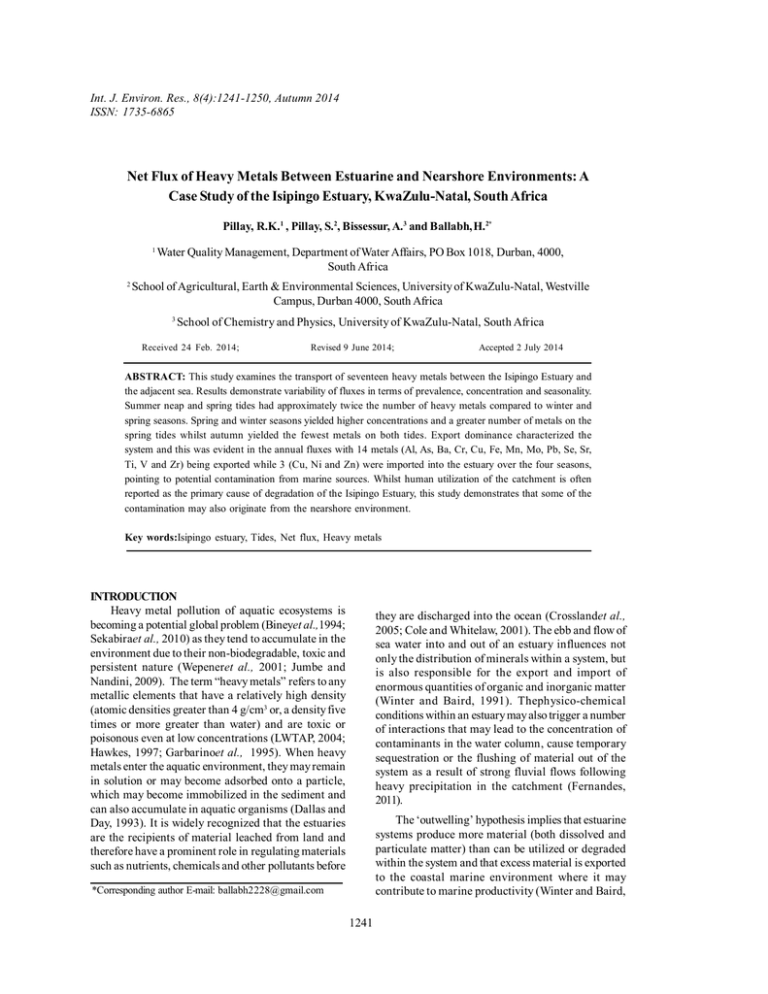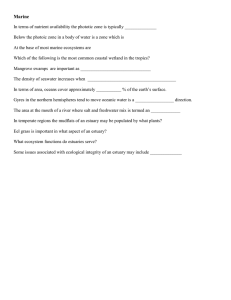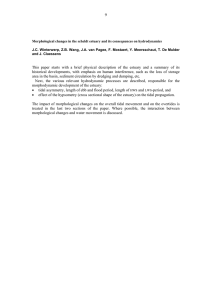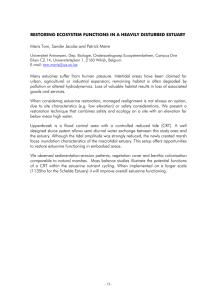D--Autumn -2014-papemaker-2014
advertisement

Int. J. Environ. Res., 8(4):1241-1250, Autumn 2014 ISSN: 1735-6865 Net Flux of Heavy Metals Between Estuarine and Nearshore Environments: A Case Study of the Isipingo Estuary, KwaZulu-Natal, South Africa Pillay, R.K.1 , Pillay, S.2, Bissessur, A.3 and Ballabh, H.2* 1 2 Water Quality Management, Department of Water Affairs, PO Box 1018, Durban, 4000, South Africa School of Agricultural, Earth & Environmental Sciences, University of KwaZulu-Natal, Westville Campus, Durban 4000, South Africa 3 School of Chemistry and Physics, University of KwaZulu-Natal, South Africa Received 24 Feb. 2014; Revised 9 June 2014; Accepted 2 July 2014 ABSTRACT: This study examines the transport of seventeen heavy metals between the Isipingo Estuary and the adjacent sea. Results demonstrate variability of fluxes in terms of prevalence, concentration and seasonality. Summer neap and spring tides had approximately twice the number of heavy metals compared to winter and spring seasons. Spring and winter seasons yielded higher concentrations and a greater number of metals on the spring tides whilst autumn yielded the fewest metals on both tides. Export dominance characterized the system and this was evident in the annual fluxes with 14 metals (Al, As, Ba, Cr, Cu, Fe, Mn, Mo, Pb, Se, Sr, Ti, V and Zr) being exported while 3 (Cu, Ni and Zn) were imported into the estuary over the four seasons, pointing to potential contamination from marine sources. Whilst human utilization of the catchment is often reported as the primary cause of degradation of the Isipingo Estuary, this study demonstrates that some of the contamination may also originate from the nearshore environment. Key words:Isipingo estuary, Tides, Net flux, Heavy metals INTRODUCTION Heavy metal pollution of aquatic ecosystems is becoming a potential global problem (Bineyet al.,1994; Sekabiraet al., 2010) as they tend to accumulate in the environment due to their non-biodegradable, toxic and persistent nature (Wepeneret al., 2001; Jumbe and Nandini, 2009). The term “heavy metals” refers to any metallic elements that have a relatively high density (atomic densities greater than 4 g/cm3 or, a density five times or more greater than water) and are toxic or poisonous even at low concentrations (LWTAP, 2004; Hawkes, 1997; Garbarinoet al., 1995). When heavy metals enter the aquatic environment, they may remain in solution or may become adsorbed onto a particle, which may become immobilized in the sediment and can also accumulate in aquatic organisms (Dallas and Day, 1993). It is widely recognized that the estuaries are the recipients of material leached from land and therefore have a prominent role in regulating materials such as nutrients, chemicals and other pollutants before they are discharged into the ocean (Crosslandet al., 2005; Cole and Whitelaw, 2001). The ebb and flow of sea water into and out of an estuary influences not only the distribution of minerals within a system, but is also responsible for the export and import of enormous quantities of organic and inorganic matter (Winter and Baird, 1991). Thephysico-chemical conditions within an estuary may also trigger a number of interactions that may lead to the concentration of contaminants in the water column, cause temporary sequestration or the flushing of material out of the system as a result of strong fluvial flows following heavy precipitation in the catchment (Fernandes, 2011). The ‘outwelling’ hypothesis implies that estuarine systems produce more material (both dissolved and particulate matter) than can be utilized or degraded within the system and that excess material is exported to the coastal marine environment where it may contribute to marine productivity (Winter and Baird, *Corresponding author E-mail: ballabh2228@gmail.com 1241 Pillay et al. Isipingo estuary, located on South Africa’s eastern seaboard and the adjacent marine environment. No such prior research has been conducted for this environment, although numerous assessments of the contaminant status within the estuary have led to the system being rated as ‘highly degraded’. These assessments have almost always implicated anthropogenic industrial activity as the prime contributor to the high pollution levels. This study therefore investigates the possible contribution and implications of heavy metals from the marine source whilst simultaneously assessing the efficacy of the estuarine system in exporting accumulated and temporarily stored contaminants. 1991). Research by Baird and Winter (1989) and Dame et al., (1996) have demonstrated a net export of particulate organic material and inorganic nutrients from estuaries to the coastal environment. It is generally assumed that the contaminant levels measured within an estuary are comparatively the same as that exchanged with the near shore environment (Fernandes, 2011). However, this is not an entirely accurate statement. Quantification of the total contaminant transfer necessitates the computation of the total contaminant transport for the duration of complete tidal cycles (Pillay, 1988). The net material exchange is the difference between the flood and ebb transport values. Measuring the flood and ebb transport levels are difficult due to the variable change in water levels with time and the reversal in flow direction with the change from flood to ebb and vice versa. The following aspects also compound the problem: change in flow velocities experienced during the flood and ebb tidal cycle, unequal duration of the flood and ebb tidal cycles and seasonal variations (Fernandes, 2011). The Isipingoestuary is located along the eastern seaboard of South Africa in the Province of KwaZuluNatal (Fig. 1). The Isipingoestuary falls under the jurisdiction of the eThekwini Municipality, which makes the municipality one of th e authorities responsible for managing this system. The mouth of the Isipingo River consists of both a lagoon and an estuary located at 30°00’S; 30°57’E. According to Ramm (1987), there is tidal exchange between the estuary and the sea but limited exchange with the lagoon area, conditions that were observed for the duration of this study. The Isipingo River catchment area is estimated 51 km2 (Kalicharran and Diab 1993; Brand 1967) and has been intensively developed. Tides along this coastline are semi-diurnal and the main wave approach is south easterly which generates longshore drift currents responsible for northerly transport of sediments and material (Fernandes, 2011). Nearshore cell circulation and morphodynamics can create a periodic reversal of longshore currents (Fernandes, 2011). The dominant wind direction is north to northeasterly (Pillay, 1996). The mean annual rainfall of the study area is approximately 1000 mm, with a range from 900 mm to 1500 mm (DWAF, 2004a). The majority of rainfall experienced in the catchment occurs during the summer months of October to March with the winter months of June to August being the driest (Ward, 1980) therefore fluvial flow and flushing capabilities are stronger in summer. A mean annual temperature of 20.2°C with an annual variation of 4°C is experienced (Ward, 1980). Within the South African context, estuary mouths may be open to the sea, or closed by barriers for part of, or all the year depending on their characteristics and the prevailing environmental conditions. In South Africa, most estuaries are flood-dominant, which means that it is common for flood tides to move in more material than that removed by the ebb tides (Winter and Baird, 1991; Binning and Baird, 2001). In KwaZulu-Natal however, there are a number of estuaries that are perched and are therefore ebb-dominant (Pillay, 1998).Internationally, considerable attention has focused on the quantity and fate of materials entering river and estuarine systems and eventually entering the coastal environment. There is limited information available in South Africa with respect to the exchange of material, in particular heavy metals, between estuaries and the near-shore environment. Studies undertaken on some micro tidal estuaries in South Africa showed that these estuaries were net importers of material (i.e. import material from marine environment into the estuary) (Baird and Winter, 1992; Taylor and Allanson, 1995). The study on the Swartkops Estuary near Port Elizabeth on the other hand, investigated carbon flux, inorganic and organic particulate matter transfer between estuaries and the sea (Baird et al., 1987; Winter et al, 1996) and concluded that the system was a net exporter of total suspended particulate matter. The research by Fernandes (2011) conducted on the Isipingoestuary concentrated solely on the net flux or exchange of nitrates between the estuarine and near shore environment. In this study, we focus on the transport of a range of heavy metals between the The Isipingo catchment was designated for major industrial development during the period of the mid1900 and following the diversion of the Umlazi River (which previously joined the Isipingo estuary at the mouth) in the late 1950’s, the reduced fluvial flows caused protracted mouth closure of the estuary and necessitated the construction of twin concrete pipes (Fig. 2) to facilitate and maintain the tidal exchange between the estuary and the sea (Begg, 1978). The 1242 Int. J. Environ. Res., 8(4):1241-1250, Autumn 2014 Fig. 1. The Isipingo study area and location of the Isipingo estuary Fig. 2. Length and position were twin pipes meet the sea Prospecton. There are also three marine outfalls that discharge industrial effluent located to the south of the Isipingo estuary. upstream water quality is deemed to be poor and is attributed to the numerous modifications that have occurred in the catchment (Brand et al., 1967; SSI, 2011). Further upstream lie the extensive residential areas of Umlazi and Isipingo while closer to the estuary is located the Prospecton and Isipingo industrial areas (Fig. 3). A large waste water and sewage effluent treatment plant is located downstream of Umlazi. The area to the north east of the estuary was previously used as a major national airport until it was recently moved to a new location. The Isipingo River has been canalized along the stretch of river that runs through Clearly, heavy industrialization of the area has had impacts on the estuary. For instance, the study conducted by Grobler (1992) with respect to heavy metal contamination of the Isipingo River and Estuary concluded that there were ‘very high iron, mercury, lead and zinc concentrations throughout the entire system while the following metals also significantly exceeded the criteria; aluminium, boron, chromium, 1243 Net Flux of Heavy Metals Between Estuarine Fig. 3. Developments surrounding the Isipingo estuary and Prospecton Canal System (PCS) (adapted from SSI, 2011) Metal concentrations were determined using Inductively Coupled Plasma Optical Emission Spectrometry (ICP-OES) for the following: Aluminium (Al), Arsenic (As), Barium (Ba), Cobalt (Co), Chromium (Cr), Copper (Cu), Iron (Fe), Manganese (Mn), Molybdenum (Mo), Nickel (Ni), Lead (Pb), Selenium (Se), Strontium (Sr), Titanium (Ti), Vanadium (V), Zinc (Zn) and Zirconium (Zr). A set of standards was developed for all of the aforementioned metals derived from a set of common standard solution of varying metal concentrations. The solution was then injected into the OES and the standard concentrations and intensity readings plotted on graphs. The prepared water samples were injected into the OES and the intensity reading obtained were then used to calculate the metal concentrations. The water samples collected were then injected into the OES. The intensity readings obtained were then used to calculate the actual concentration of each metal by using its specific graph of standards. The flux of a chemical constituent entering or leaving the estuary is dependent on its concentration in the water; which in turn is related to the physico-chemical properties of the aquatic environment. Estuarine mixing behaviour of a copper, manganese and molybdenum’. Consequently this study is important as it would help ascertain whether the estuary serves as a source or sink for the said heavy metals and the extent to which the marine environment contributes to heavy metal removal from or accumulation in the estuary. MATERIAL& METHODS Water samples were collected at hourly intervals over complete tidal cycles as proposed by Kjerfveet al., (1980). The samples were taken at the estuary inlet (i.e. at the twin pipes at mid-depth on a seasonal basis and during consecutive Spring and Neap tides). One liter polyethylene bottles were utilized to collect the samples which were then carefully labeled and stored at approximately 4°C. These were transferred for analysis to the laboratory within a 24 hour. On site parameters measured included the flow velocity and direction and, the stage height of water in the tidal pipes. The latter was utilized in Equation 1 to calculate the cross sectional area of the segment of water in the pipe at the given sampling time: A= h ( 3h 2 + 4 c 2 ) 6c (1) 1244 Int. J. Environ. Res., 8(4):1241-1250, Autumn 2014 were exported during this period with the exception of Ba, Ni, Se and Zn. A number of heavy metals were undetected during the winter Neap tide, with the exception of As, Ba and Sr which were exported and Se which was imported. constituent is derived mathematically by studying the relationship between the concentration of the constituent and the prevailing salinity (Boyle et al., 1974; Officer and Lynch, 1981; Wen et al., 1999). For purposes of this study and following reconnaissance survey observations, a homogenous salinity distribution across was assumed. Constituents flux exiting the estuary could then be determined from the relations determined as: FE = QC° (2) On a seasonal basis, a majority of heavy metals were undetectedduring the Neap tide for all seasons except summer. This may be attributed the relatively stronger ebb flow recorded during the summer Neap tide. The Isipingo system therefore displayed a greater flushing ability during this period. The estuary behaved as a net exporter of certain heavy metals during the Neap tide of all seasons except winter during which 4.42 kg of Se was imported (Table 1). During certain periods within the spring, summer and winter Spring tides, the higher flow velocity of the flood resulted in someimport. Sr was exported during all seasonal Spring and Neap tides. Arsenic was also exported during all seasonal Spring and Neap tides with the exception of the spring Neap tide. The highest amount of As was exported during the spring Spring tide and the summer Neap tide. And the flux of constituents entering the estuary on the flood tide is given as: FF = QC* (3) The total fluxes to the ocean (FET) are estimated by integrating all ebb fluxes for the duration of the ebb flow whilst the same process was employed in determining the total import loading (FFT) on the flood flow. The difference between these flux totals yields the net tran sport of the constituents un der consideration. The net flux is an important parameter that provides a measure of the flushing capability of the estuary and hence its ability to maintain a relatively healthy status. The analysis of variance (ANOVA) was used in assessing the significance of the transports between and within specified parameter groups. On an annual basis all metals sampled for are exported with the exception of Cu, Ni and Zn (Table 2 together with Figs 6, 7 and 8) demonstrating the flushing capability of the estuary. However, the likelihood of import of Cu, Ni and Zn being adsorbed onto estuarine sediments exists, resulting in the estuary serving as a sink for these heavy metals. Cu, Ni and Zn can have deleterious effects on aquatic organisms depending on the physical and chemical conditions of the estuarine body, although the toxicity of Cu is reduced in the presence of Zn (Dallas and Day, 1993). Across all seasons and tidal events, the ebb flow is more dominant; however, Spring tides do result in a larger tidal prism and therefore greater transport volumes. RESULTS & DISCUSSION The Isipingo estuary experiences tidal asymmetry throughout the year with a dominant ebb flow (Table 1). During the spring Spring tide, the estuary exported Al, As, Ba, Cu, Fe, Mo, Ni, Sr and V and imported Se, Ti and Zn (Fig. 4). The spring Neap tide in comparison to the other seasonal Neap tides was unique in that all heavy metals were either absent or their recorded concentrations below detection limits, with the exception of Sr which was exported during this tidal cycle (Fig. 5). The summer Spring tide demonstrated a net import of heavy metals Cr, Cu, Ni and Se. The remaining heavy metals during this period were exported. The system was dominantly export orientated during the summer Neap tide and behaved uniquely when compared to the spring, autumn and winter Neap tides in that the concentrations of the majority of heavy metals targeted were actually detected in the water column (Fig. 4 Table 1). During the autumn Spring and Neap tides As, Ba, Se and Sr were exported with the autumn Spring tide exporting a much higher volume of these heavy metals in comparison to the autumn Neap tide. With reference to Table 1, the winter Spring tide demonstrated that Al, Cu and Zr were the only heavy metals imported into the estuary. All other heavy metals During the spring, summer and winter Spring tides as well as the winter Neap tide, there was a net import of a number of heavy metals into the estuary (Table 1). During these periods, the concentrations of the heavy metals recorded during the flood flows were greater than those of the ebb flows. This may be attributed to the existence of higher concentrations of these heavy metals in the nearshore environment. The actual source of these higher concentrations did not form part of this study but it is noteworthy to mention that possible anthropogenic sources such as marine outfalls of industrial and sewage effluent are located to the south of the Isipingoestuary at the coastal town of Amanzimtoti. Estuaries located to the south of the study site could also serve as potential sources. The northward longshore drift coupled with nearshore cell circulation may result increased concentrations of 1245 Pillay et al. Table 1. Net flux of heavy metals over a tidal cycle in kilograms (kg) Net Flux (kg) Heavy ST NT ST NT ST NT ST NT metals (spring) (spring) (summer) (summer) (autumn) (autumn) (winter) (winter) Al 37.42 0 37.93 195.17 0 0 (*)26.50 0 As 1644.05 0 121.15 1362.41 125.65 20.49 2.81 28.78 Ba 4.21 0 0 0 451.65 74.60 0 152.1 Cr 0 0 (*)26.36 41.42 0 0 9.83 0 Co 0 0 33.17 23.23 0 0 4.21 0 Cu 34.24 0 (*)157.64 0 0 0 (*)19.49 0 Fe 71.91 0 72.64 287.27 0 0 8.67 0 Pb 0 0 36.97 30.51 0 0 56.81 0 Mn 0 0 5.26 25.34 0 0 3.51 0 Mo 28.54 0 841.77 2074.44 93.97 0 58.35 0 Ni 15.73 0 (*)309.95 43.91 0 0 0 0 Se (*)1570.54 0 (*)1.67 2432.59 982.31 257.02 0 (*)4.42 Sr 1848.53 399.5 1458.31 778.93 2741.72 386.44 481.35 956.28 Ti (*)44.69 0 0 0 0 0 1700.26 0 V 614.17 0 97.48 384.7 0 0 76.06 0 Zn (*)6.28 0 0 0 0 0 0 0 Zr 0 0 920.29 3226.31 0 0 (*)22.03 0 (*) implies net import of heavy metals to the estuary ST=Spring Tid e NT=Neap Tide Zeros indicate either the absence of the heavy metal or concentration levels below the detectio n limit Fig. 4. Net flux of heavy metals (seasonal Spring Tidal cycle) metals being detected on the flood flows. It is also important to mention that a change in wind direction and wave approach from south-westerly to northeasterlycould point to anthropogenic sources north of the study area. During the periods when the estuary served to export material, the longer duration of the ebb flow together with higher heavy metal concentrations resulted in there being no net import of material. Generally, the flood velocities recorded were higher than the ebb 1246 Int. J. Environ. Res., 8(4):1241-1250, Autumn 2014 Fig. 5. Net flux of heavy metals (seasonal Neap Tidal cycle) Fig. 6. Total seasonal and annual net flux of As, Mo, Se, Sr and Zr Fig. 7.Total seasonal and annual net flux of Al, Cr, Co, Pb, Mn and Zn 1247 Net Flux of Heavy Metals Between Estuarine Fig. 8.Total seasonal and annual net flux of Ba, Cu, Fe, Ni, Ti and V Table 2. Estimated total seasonal and annual net heavy metal flux in kilograms (kg) (Data extrapolated from Table 1) Total seasonal and a nnual net flux (kg) Heavy metals spring summer autumn winter Total per annum Al 3367.8 209 79 0 (*)2385 21961.8 As 147964.5 133520.4 13152.6 2843 .1 297480.6 Ba 378.9 0 47362.5 13689 61430.4 Cr 0 1355.4 0 884.7 224 0.1 Co 0 5076 0 378.9 545 4.9 Cu 3081.6 (*)14187 .6 0 (*)1754.1 (*)12860.1 Fe 6471.9 32391.9 0 780.3 39644.1 Pb 0 6073.2 0 5112 .9 11186.1 Mn 0 2754 0 315.9 306 9.9 Mo 2568.6 262458.9 8457.3 5251 .5 278736.3 Ni 1415.7 (*)23943 .6 0 0 (*)22527.9 Se (*)141348.6 218782.8 111539.7 (*)3 97.8 188576.1 Sr 202322.7 201351.6 281534.4 129386.7 814595.4 Ti (*)4022.1 0 0 153023.4 149001.3 V 55275.3 43396.2 0 6845 .4 105516.9 Zn (*)565.2 0 0 0 (*)565.2 Zr 0 373194 0 (*)1982.7 371211.3 (*) implies net import of heavy metals to the estuary ST=Spring Tid e NT=Neap Tide Zeros indicate either the absence of the heavy metal or concentration levels below the detection limit velocities although the duration of the former was much shorter. On average, the ebb flow was dominant during 75% of the tidal cycle duration. The higher export of metals during the summer period, both in terms of concentration and variety of metals may be attributed to increased industrial pollution, typical higher precipitation and surface runoff. The drier months typically reduces the flushing capabilities of the system with a reduction in the volume of material exported. The variation in heavy metal concentrations indicates that there are conditions occurring within the Isipingo estuary system which may at various times in the year result in the system acting as a sink and/or a source of heavy metals. Results of the ANOVA of the seasonal net flux over the neap and spring tides are presented in Table 3. There was no significant flux differences for heavy metal concentrations displayed seasonally (p>0.05 and 1248 Int. J. Environ. Res., 8(4):1241-1250, Autumn 2014 Table 3 . Results of ANOVA of heavy metals between seasons and tides (Spring and Neap) Source of Variation SS df MS F p-value F crit Tides 5.01E+06 7 7.16E+05 2 .43 0.02 2.08 Seasons 3.75E+10 3 1.25E+10 2 .03 0.12 2.75 SS = Sum of squares df = Degrees of Freedom MS = Mean squares Table 4.Variance of heavy metal concentrations over seasonal and tidal cycles (in order of increasing variance) Seasonal Sp ring and Neap Tides Variance Season Variance spring Neap Tide autumn Neap Tide winter Neap Tide winter Sp ring Tide summer Spring Tide spring Spring Tide autumn Spring Tide summer Neap Tide 9388 11830 53862 173620 177400 432054 473386 1023145 Winter Spring Autumn Summer 2.14E+09 4.18E+09 5.1E+09 1.32E+10 and near shore cell circulation. There are also periods during which heavy metals are undetected in the water column. One aspect that requires further research is on the retention times as well as an assessment of the heavy metal budget for the system. These factors would need to be considered in the overall management of the estuarine system. F <Fcrit), however a statistically significant difference between the Spring and Neap tide fluxes exist (p<0.05 and F >Fcrit). This is expected because of the higher tidal prisim experienced on the Spring tide and hence the greater volume of material exchanged. The highest flux variance occurred in the summer season with winter displaying the lowest variance of all the seasons. During summer, the larger tidal prism concomitant with larger fluvial flows is responsible for the higher flux variations. The greatest variance was displayed for the summer Neap Tides (Table 4). During the summer months, higher fluvial flows result in more heavy metals being flushed through the system accounting for part or all of the higher variance display during the summer Neap Tide. Many heavy metals were not present in the water column or were below the detection limit in the spring and autumn Neap Tides contributing to lower variance at this time. ACKNOWLEDGEMENT KshiraJuggoo and YashmicaJeon are acknowledged for conducting all laboratory analysis. REFERENCES Baird, D. and Winter, P.E.D. (1989). Annual flux budget of dissolved inorganic nutrients through a well mixed estuary. In: Michaelis W.(Ed.) Coastal and Estuarine Studies 36: Estuarine Water Quality Management: Monitoring, Modelling and Research, Springer-Verlag, New York.190, 335-340. Baird, D. and Winter, P.E.D. (1992). Flux of inorganic nutrients and particulate carbon between a Spartina maritime salt marsh and the Swartkops estuary, eastern Cape. Southern AfricanJournal of Aquatic Sciences,18, 64-73. CONCLUSION This study demonstrates that significant quantities of the suite of heavy metals analysed for are being exported on an annual basis from the Isipingo estuary with the exception of Cu, Ni and Zn. Although the Isipingo estuary is a net exporter of heavy metals, there is a net import of certain heavy metals (Al, Cr, Cu, Ni, Se, Ti, Zn and Zr) into the estuary during certain seasonal tidal cycles. The ebb flow has a much longer duration than the flood flow throughout the seasonal tidal cycles although the flood velocities are greater than the ebb velocities. There are certain periods during which the estuary serves as a net importer of certain heavy metals which may attribute to long shore drift Baird, D., Winter, P.E.D. and Wendt, G. (1987). The flux of particulate material through a well-mixed estuary.Continental Shelf Research, 7,1399-1403. Biney, C., Amazu, A.T., Calamari, D., Kaba, N., Mbome, I. L., Naeve, H., Ochumba, P.B.O., Osibanjo, O., Radegonde, V. and Saad, M.A.H. (1994). Review of heavy metals in African aquatic environment, Ecotoxicology and Environmental Safety,31, 134-159. Binning, K. and Baird, D. (2001).Survey of heavy metal in the sediments of the Swartkops Rivers Estuary, Port Elizabeth South Africa, Water SA, 27, 461-466. 1249 Pillay et al. Boyle, E., Collier, R., Dengler, A., Edmond, J., Ng, A. and Stallards, R. (1974).On the chemical mass balance in estuaries. Geochemical etCosmochemicaActa, 38(2), 17191728. LWTAP, (2004).Lenntech Water Treatment and Air Purification, Water Treatment, Published by Lenntech, Rotterdamseweg, Netherlands. www.excelwater.com/thp/ filters/Water-Purification.htm Brand, P.A. (1967). Water quality and abatement of pollution in Natal Rivers: Survey of the Three Rivers Region.Natal Town and Regional Planning Report, Volume 13.The Natal Town and Regional Planning Commission, Pietermaritzburg, South Africa. Officer, C. and Lynch, D. (1981).Dynamics of mixing in estuaries. Estuarine, Coastal and Shelf Sci., 12, 525-533. Pillay, S. (1988) An analysis and simulation of correlation error in net flux determinations in salt marsh tidal channel systems. Masters Thesis.Department of Geological Sciences, University of South Carolina. Cole, J.A. and Whitelaw, K. (2001). Metal fluxes in the Mersey Narrows. Hydrology and Earth System Sciences, 5, 103-118. Pillay, S. (1996).Sedimentology and dynamics of the Mflolozi and St Lucia Estuaries, KwaZulu-Natal, South Africa.Doctorate Thesis. Department of Geology and Applied Geology, University of Natal. Crossland, C.J., Baird, D., Ducrotoy, J.P. and Lindeboom, H. (2005). The coastal zone – a domain of global interactions, p 1-37 . In CJ Crossland, HH Kremer, HJ Lindeboom, JI Marshall Crossland and MDA Le Tissier [eds], Coastal fluxes in the anthropocene. International Geoshere – Biosphere Programme Series, Springer. Ramm, A. (1987). Rehabilitation of the Isipingo Estuary and Lagoon:Isipingo Estuary and Lagoon. Natal Town and Regional Planning Supplementary Report, Volume25.The Natal Town and Regional Planning Commission, Pietermaritzburg, South Africa. Dallas, H.F. and Day, J.A. (1993). The Effect of Water Quality Variables on riverine Ecosystems: A Review. WRC Report No.TT 61/93.Water Research Commission. Pretoria. South Africa. Sekabira, K., OryemOriga, H., Basamba, T. A., Mutumba, G. and Kakudidi, E. (2010). Assessment of heavy metal pollution in the urban stream sediments and its tributaries, Int. J. Environ. Sci. Tech., 7(3), 435-446. Dame, R.F. and Allen, D.M. (1996).Between estuaries and the sea, Journal of Experimental Marine Biology and Ecology, 200, 169-185. SSI, (2011).Stewart Scott International Engineers and Environmental Consultants.Isipingo Estuary Management Plan Part 1: Situation Analysis. Report for the Coastal, Stormwater and Catchment Management Department, eThekwini Municipality. DWAF, (2004a). Department of Water Affairs and Forestry National Water Conservation and Water Demand Management Strategy. Department of Water Affairs and Forestry, Pretoria, South Africa. 33pp. Swart, H. (1987). Rehabilitation of the Isipingo Estuary and Lagoon: Engineering remedies. Natal Town and Regional PlanningSupplementaryReport, Volume 45.The Natal Town and Regional Planning Commission, Pietermaritzburg, South Africa. Fernandes, S. (2011). A Study of the net flux of nitrates from three estuaries of the eThekwini Municipality of Durban, KwaZulu-Natal. Unpublished Masters Thesis, School of Environmental Science, University of KwaZuluNatal-Westville Campus. Taylor, D.I. and Allanson, B.R. (1995). Organic carbon fluxes between a high marsh and estuary, and the inapplicability of the Outwelling Hypothesis, Marine Ecology Progress Series, 120, 263-270. Garbarino, J.R., Hayes, H., Roth, D., Antwelder, R., Brinton, T.I. and Taylor, H. (1995).Contaminants in the Mississippi River, U. S. Geological Survey Circular 1133, Virginia, U.S.A. [Accessed June 2011] www.pubs.usgs.gove/circ/circ1133. Ward, C.J. (1980). The plant ecology of the Isipingo Beach area, Natal, South Africa, Memoirs of the Botanical Survey of South Africa, 45,1-147. Grobler, D.F. (1992).A water quality investigation of the Isipingo River and Estuary, Natal. Department of Water Affairs and Forestry Hydrological Research Institute Report Number N/U600/REQ/3291, Department of Water Affairs and Forestry, Pretoria. 32pp. Wen, L.S., Santschi, P., Gill, G. and Paternostro, C. (1999). Estuarine trace metal distributions in Galveston Bay: Importance of colloidal forms in dissolved phase speciation. Marine Chemistry,63, 185-212. Hawkes, J.S. (1997). Heavy metals.J. Chem. Educ., 74(11), 1374. Wepener, V., Van Vuren, J.H.J and Du Preez, H.H. (2001).Uptake and distribution of a copper, iron and zinc mixture in gill, liver and plasma of a freshwater teleost, Tilapia sparmanii. Water SA.,21(1), 990-1018. Jumbe, A.S. and Nandini, N. (2009).Heavy metals assessment of wetlands around Peenya industrial area, Bangalore, India. J. Res. Environ. Life Sci, 2, 23-30. Winter, P.E.D. and Baird, D. (1991).The exchange of phosphate between the Swartkops estuary and Algoa Bay.South African Journal of Science,87, 192-197. Kalicharran, S. and Diab, R. (1993). Proposals for Rehabilitation and Management of Isipingo Lagoon and Estuary, South Africa, Environmental Management, 17, 759763. Winter, P.E.D., Schlacher, T.A. and Baird, D. (1996). Carbon flux between an estuary and the ocean: a case for outwelling. Hydrobiologia,337,123-132. Kjerfve, B. and McKellar Jr, H. N. (1980).Time Series Measurements of Material Fluxes. Estuarine Perspectives, 341-357. 1250






